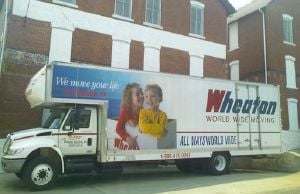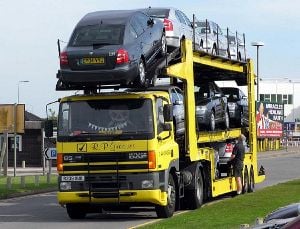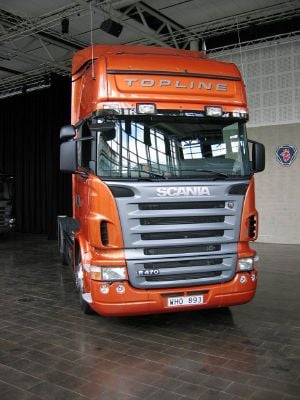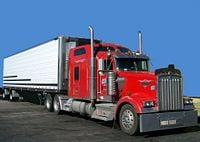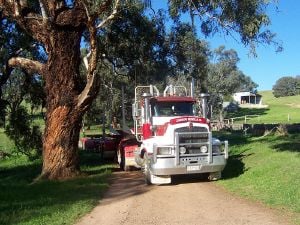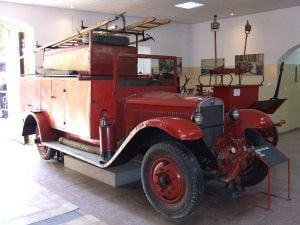Difference between revisions of "Truck" - New World Encyclopedia
(imported latest version of article from Wikipedia) |
Rosie Tanabe (talk | contribs) |
||
| (31 intermediate revisions by 5 users not shown) | |||
| Line 1: | Line 1: | ||
| − | {{ | + | {{Images OK}}{{Approved}}{{Copyedited}} |
| − | {{ | + | :''"Lorry" redirects here.'' |
| − | [[Image: | + | [[Image:MuncyTruck.jpg|thumbnail|A "straight-job" [[International Harvester|International]] moving truck.]] |
| + | |||
| + | |||
| + | A '''truck''' is a motorized vehicle usually used for transporting bulk goods, materials, or equipment. The word "truck" comes from the [[Greek language|Greek]] word ''trochos'', meaning "wheel." In [[North America]], the big wheels of wagons were called trucks. When the [[gasoline]]-engine-driven trucks became available, these were called "motor trucks." | ||
| + | |||
| + | '''Lorry''' is a British term for a truck, but it is used only for the medium and heavy types. A [[van]], [[pickup truck]], or [[Jeep]] would not be called a "lorry." Other languages have [[loanword]]s based on these terms, such as the [[Malay language|Malay]] ''lori'' and the [[Mexican Spanish]] ''troca'' (or ''pickup'' in northern [[Mexico]]). | ||
| + | {{toc}} | ||
| + | |||
[[Image:truck.car.transporter.arp.750pix.jpg|thumb|right|DAF [[Tractor unit|tractor]] with an auto-transport [[semi-trailer truck]] carrying [[Škoda Octavia]] cars in [[Cardiff, Wales]]]] | [[Image:truck.car.transporter.arp.750pix.jpg|thumb|right|DAF [[Tractor unit|tractor]] with an auto-transport [[semi-trailer truck]] carrying [[Škoda Octavia]] cars in [[Cardiff, Wales]]]] | ||
| − | |||
| − | + | In [[Australian English|Australia]] and [[New Zealand English|New Zealand]], a small vehicle with an open back is called a '''ute''' (short for "utility vehicle") and the word "truck" is reserved for larger vehicles. | |
| − | |||
| − | + | ==Anatomy of a truck== | |
| − | + | Trucks are complex machines that generally share certain common features. Each truck has a [[chassis]], a [[Cabin (truck)|cab]], an area for placing [[cargo]] or equipment, [[axle]]s, [[suspension (vehicle)|suspension]] and [[wheel]]s, an [[engine]], and a [[drivetrain]]. It usually has [[pneumatic]], [[hydraulic]], [[water]], and [[electrical]] systems. Many trucks also tow one or more [[Trailer (vehicle)|trailers]] or [[semi-trailer]]s. | |
| + | |||
| + | ===Cab=== | ||
| + | [[Image:Scania R470 topline.JPG|thumb|[[Scania AB|Scania]] R470 flat nose truck]] | ||
| + | |||
| + | The [[Cabin (truck)|cab]] is an enclosed space where the driver is seated. A '''sleeper''' is a compartment attached to the cab where the driver may rest while not driving, sometimes seen in [[semi-trailer truck]]s. | ||
| + | |||
| + | A cab may be built in one of a few possible configurations: | ||
| + | |||
| + | * In a ''[[cab over]] engine'' (COE) or ''flat nose'', the driver is seated on top of the front axle and the engine. This design is almost ubiquitous in [[Europe]], where overall truck lengths are strictly regulated. They were common in the United States, but they lost prominence when permitted length was extended in the early 1980s. To access the engine, the whole cab tilts forward, earning this design the name of ''tilt-cab''. This type of cab is especially suited to the delivery conditions in Europe, where many roads follow the layout of much older paths and trackways that require the additional turning capability of the cab over engine type. | ||
| + | |||
| + | [[Image:American truck.JPG|thumb|200px| US truck with ''long nose'' and ''sleeper cab'']] | ||
| + | |||
| + | * ''Conventional'' cabs are the most common in [[North America]] and are known in the UK as ''American cabs''. The driver is seated behind the engine, as in most passenger cars or pickup trucks. Conventionals are further divided into large car and aerodynamic designs. A "large car" or "long nose" is a conventional truck with a long hood (6 to 8 feet (1.8 to 2.4 m) or more). With their very square shapes, these trucks experience a lot of wind resistance and typically consume more fuel. They also provide somewhat poorer visibility than their aerodynamic or COE counterparts. By contrast, ''aerodynamic'' cabs are very streamlined, with a sloped hood and other features to lower drag. | ||
| + | |||
| + | * There are also some ''cab beside engine'' designs, but they are rare. | ||
===Engine=== | ===Engine=== | ||
| − | |||
| − | + | Trucks can be equipped with all types of engines. Small trucks such as [[Sport utility vehicle|SUV]]s or [[pickup truck|pickup]]s, and even light, medium-duty trucks in [[North America]] and [[Russia]] use [[gasoline]] engines. Most heavier trucks use [[four stroke cycle|four stroke]] [[turbocharger|turbo]] [[intercooler]] [[diesel]] engines, although there are alternatives. Huge off-highway trucks use locomotive-type engines, such as a [[V12 engine|V12]] [[Detroit Diesel]] [[two stroke cycle|two stroke]] engine. | |
| − | In the European union all truck engines must comply with Euro 4 regulations | + | North American manufactured highway trucks almost always use an engine built by a third party, such as [[Caterpillar Inc.|CAT]], [[Cummins]], or [[Detroit Diesel]]. The only exceptions to this are [[Volvo Trucks|Volvo]] and its subsidiary [[Mack Trucks]], which are available with own engines. [[Freightliner]], [[Sterling Trucks]] and [[Western Star]], [[subsidiary|subsidaries]] of [[DaimlerChrysler]], are available with [[Mercedes-Benz]] and Detroit Diesel engines. Trucks and buses built by [[Navistar International]] can also have International engines. The [[Sweden|Swedish]] truckmaker Scania claims they stay away from the United States-market because of this third party tradition. |
| + | |||
| + | In the European union all truck engines must comply with Euro 4 regulations. The regulations will become more severe in 2008 with the introduction of Euro 5. | ||
===Drivetrain=== | ===Drivetrain=== | ||
[[Image:Truck.jpg|thumb|left|A logging truck]] | [[Image:Truck.jpg|thumb|left|A logging truck]] | ||
| − | |||
| − | |||
| − | + | Small trucks use the same types of [[transmission (mechanics)|transmissions]] as most [[automobile|cars]] that have either an [[automatic transmission]] or a [[manual transmission]] with [[synchromesh|synchronizer]]s. Bigger trucks often use manual transmissions without synchronizers that have less bulk and weight, although synchromesh transmissions are used in larger trucks as well. Transmissions without synchronizers known as "crash boxes" require double clutching for each shift, (which can lead to repetitive motion injuries), or a technique known colloquially as "floating"—a method of changing gears that doesn't use the clutch, except for starts and stops, due to the physical effort of double clutching especially with non power assisted clutches, faster shifts, and less clutch wear. The so-called skip changing is also widely used—in principle, the operation is the same, but it requires neutral be held slightly longer than single gear change. | |
| + | |||
| + | Common North American setups include 9, 10, 13, 15, and 18 speeds. [[Automatic transmission|Automatic]] and [[semi-automatic transmission]]s for heavy trucks are becoming more and more common, due to advances both in transmission and engine power. In Europe, 8, 10, and 12 gears are common on larger trucks with manual transmission, while automatic or semiautomatic transmission may have anything from 5 to 12 gears. Almost all heavy truck transmissions are of a "range (double H shift pattern) and split" type, where range change and so called half gears or splits are air operated and always preselected before the main gears selection. | ||
| + | |||
| + | In Europe, more new trucks are being bought with automatic or semi-automatic transmission. The primary reason may be that such transmissions give a driver more time to concentrate on the road and traffic conditions. Also, some drivers are claiming that driving a manual transmission can damage their knees. | ||
===Chassis=== | ===Chassis=== | ||
| − | [[Image:Polski Fiat 621 L Warsaw.JPG|thumb|right|A [[Poland|Polish]] | + | [[Image:Polski Fiat 621 L Warsaw.JPG|thumb|right|A [[Poland|Polish]] 1936-built Fiat 621 L [[fire truck]] in [[Warsaw]], Poland]]. |
| − | The [[chassis]] or frame of a truck is commonly constructed mainly of two [[beam (structure)|beams]], and several [[crossmembers]]. A truck chassis consists of two parallel straight C-shaped beams, or in some cases stepped or tapered beams, these held together by crossmembers. In most instances, gussets help attach the crossmembers to the beams. The "C-shape" of the beams has a middle vertical and longer side, and a short horizontal flange at each end; the length of the beams is variable. | + | |
| + | The [[chassis]] or frame of a truck is commonly constructed mainly of two [[beam (structure)|beams]], and several [[crossmembers]]. A truck chassis consists of two parallel straight C-shaped beams, or in some cases stepped or tapered beams, these held together by crossmembers. In most instances, gussets help attach the crossmembers to the beams. The "C-shape" of the beams has a middle vertical and longer side, and a short horizontal flange at each end; the length of the beams is variable. The chassis is usually made of [[steel]], but can be made (whole or in part) of [[aluminum]] for a lighter weight. | ||
| + | |||
| + | The integrity of the chemical composition and structure of the beams is of utmost importance to maintain its strength, to help prevent cracking or breaking of the beams, and to help maintain rigidity and flexibility of the frame. Welding, drilling, and other types of modifications should not be performed by unlicensed individuals. The chassis is the main structure of the truck, and the other parts attach to it. A [[Drawbar (haulage)|tow bar]] may be found attached at one or both ends. | ||
==Environmental effects== | ==Environmental effects== | ||
| − | |||
| − | + | Trucks contribute to air, noise, and [[water pollution]] in a manner similar to [[automobile]]s. In the case of [[air pollution]] emissions, a truck's emissions may actually be lower than that of an automobile on a per pound of vehicle mass basis, although the absolute level on a vehicle mile traveled basis is higher, and [[diesel]] soot is especially problematic for health.<ref>[http://www.dieselnet.com/standards/us/hd.html Truck vehicle emission standards: United States Environmental Protection Agency], Eco Point. Retrieved May 22, 2008.</ref> | |
| − | + | With respect to [[noise pollution]], trucks emit considerably higher sound levels at all speeds compared to typical automobiles. This contrast is particularly strong in the case of heavy duty trucks.<ref>[http://www.springerlink.com/content/x1707075n815g604/ C. Michael Hogan], SpringerLink. Retrieved May 22, 2008.</ref> | |
| − | Between 1985 and 2004 | + | Concerns have been raised about the effect of trucking on the environment, particularly as part of the debate on [[global warming]]. In the period from 1990 to 2003, carbon dioxide emissions from transportation sources increased by 20 percent, despite improvements in vehicle fuel efficiency.<ref>[http://www.bts.gov/publications/national_transportation_statistics/html/table_04_49.html Table 4-49: U.S. Carbon Dioxide Emissions from Energy Use by Sector] U.S. Department of Transportation. Retrieved May 22, 2008.</ref> In 2005, transportation accounted for 27 percent of U.S. greenhouse gas emission, increasing faster than any other sector.<ref>[http://epa.gov/climatechange/emissions/downloads06/07Trends.pdf ''Trends in Greenhouse Gas Emissions''], Inventory of U.S. Greenhouse Gas Emissions and Sinks. Retrieved May 22, 2008.</ref> Between 1985 and 2004 in the United States, energy consumption in freight transportation grew nearly 53 percent, while the number of ton-miles carried increased only 43 percent. |
| − | while the number of ton-miles carried increased only 43 | + | According to a 1995 U.S. Government estimate, the energy cost of carrying a ton of freight a distance of one mile averages 514 Btu for water, 337 Btu for rail, 3,100 for trucks, and nearly 20,000 for air transport.<ref>[http://www.eia.doe.gov/emeu/efficiency/ee_ch5.htm#U.S.%20Domestic%20Freight%20Transportation 5. Transportation Sector] U.S. Department of Energy. Retrieved May 22, 2008.</ref> Many environmental advocacy organizations favor laws and incentives to encourage the switch from road to rail, especially in Europe.<ref> How Government policy can realise rail freight’s role in reducing carbon emissions, Freight on Rail. </ref> |
| − | |||
| − | + | ==Quality and sales== | |
| − | + | The quality of vehicles among all heavy truck manufacturers is generally improving. However, according to some industry insiders, the industry has a long way to go before achieving the quality levels reached by [[automobile]] manufacturers. Part of the reason for this is that 75 percent of all trucks are custom built. This works against efforts to streamline and automate the assembly line. | |
| − | |||
===Heavy trucks market worldwide=== | ===Heavy trucks market worldwide=== | ||
| − | + | ||
| − | |||
{| class="wikitable" style="text-align:left" | {| class="wikitable" style="text-align:left" | ||
| − | |+Largest manufacturers in Western Europe, the U.S. and Japan, over 16 | + | |+Largest manufacturers in Western Europe, the U.S. and Japan, over 16 metric tons GVW in 2005.<ref>[http://www.sweden.se/upload/Sweden_se/english/factsheets/SI/SI_FS127c_Motor_Vehicle_industry/The_Motor_Vehicle_Industry_in_Sweden_FS127c.pdf The Motor Vehicle Industry in Sweden] The Swedish Institute. Retrieved May 22, 2008.</ref> |
|- | |- | ||
! Pos. !! Make !! Units | ! Pos. !! Make !! Units | ||
| Line 58: | Line 80: | ||
|- | |- | ||
! 2 | ! 2 | ||
| − | | [[Volvo]] ( | + | | [[Volvo]] (Volvo,[[Mack]],[[Renault]],[[UD Nissan Diesel]])|| 177,106 |
|- | |- | ||
! 3 | ! 3 | ||
| Line 76: | Line 98: | ||
|- | |- | ||
! 8 | ! 8 | ||
| − | | [[Iveco]] ( | + | | [[Iveco]] (Iveco,[[Magirus]],[[Astra]],[[Seddon Atkinson]],[[Yuejin]]) || 43,364 |
|- | |- | ||
! 9 | ! 9 | ||
| Line 84: | Line 106: | ||
| [[Volkswagen]] || 22,684 | | [[Volkswagen]] || 22,684 | ||
|} | |} | ||
| − | |||
| − | |||
| − | |||
| − | |||
| − | |||
| − | |||
| − | |||
| − | |||
| − | |||
| − | |||
| − | |||
| − | |||
| − | |||
| − | |||
| − | |||
| − | |||
| − | |||
| − | |||
| − | |||
| − | |||
| − | |||
| − | |||
| − | |||
| − | |||
| − | |||
| − | |||
| − | |||
| − | |||
| − | |||
| − | |||
| − | |||
| − | |||
| − | |||
| − | |||
| − | |||
| − | |||
| − | |||
| − | |||
| − | |||
| − | |||
| − | |||
| − | |||
| − | |||
| − | |||
| − | |||
| − | |||
| − | |||
| − | |||
| − | |||
| − | |||
| − | |||
| − | |||
| − | |||
| − | |||
| − | |||
| − | |||
| − | |||
| − | |||
| − | |||
| − | |||
| − | |||
| − | |||
| − | |||
| − | |||
| − | |||
| − | |||
| − | |||
| − | |||
| − | |||
| − | |||
| − | |||
| − | |||
| − | |||
| − | |||
| − | |||
| − | |||
| − | |||
| − | |||
| − | |||
| − | |||
| − | |||
| − | |||
| − | |||
| − | |||
| − | |||
| − | |||
| − | |||
| − | |||
| − | |||
| − | |||
| − | |||
| − | |||
| − | |||
| − | |||
| − | |||
| − | |||
| − | |||
| − | |||
| − | |||
| − | |||
| − | |||
| − | |||
| − | |||
| − | |||
| − | |||
| − | |||
| − | |||
| − | |||
| − | |||
| − | |||
| − | |||
| − | |||
| − | |||
| − | |||
| − | |||
| − | |||
| − | |||
| − | |||
| − | |||
| − | |||
| − | |||
| − | |||
== Insuring trucks for commercial hauling == | == Insuring trucks for commercial hauling == | ||
| − | Primary Liability Insurance coverage protects the truck from damage or injuries to other people as a result of a truck accident. | + | Primary Liability Insurance coverage protects the truck from damage or injuries to other people as a result of a truck accident. This truck insurance coverage is mandated by U.S. state and federal agencies and proof of coverage is required to be sent to them. Insurance coverage limits range from $35,000 to $1,000,000. Pricing is dependent on region, driving records, and history of the trucking operation. |
Motor Truck Cargo insurance protects the transporter for his responsibility in the event of damaged or lost freight. The policy is purchased with a maximum load limit per vehicle. Cargo insurance coverage limits can range from $10,000 to $100,000 or more. Pricing for this insurance is mainly dependent on the type of cargo being hauled. | Motor Truck Cargo insurance protects the transporter for his responsibility in the event of damaged or lost freight. The policy is purchased with a maximum load limit per vehicle. Cargo insurance coverage limits can range from $10,000 to $100,000 or more. Pricing for this insurance is mainly dependent on the type of cargo being hauled. | ||
| − | == | + | == Gallery == |
| − | + | <gallery> | |
| + | Image:CementTruck.jpg|A "cement mixer" (concrete transport truck) or "transit mixer." | ||
| + | Image:Scania_porteur_benne_tp.jpeg|A heavy [[Scania]] dump truck in France. | ||
| + | Image:American truck blue.JPG|U.S. [[Peterbilt]] truck - California. | ||
| + | Image:Truck_VolvoVN780.jpg|[[Volvo_Trucks|Volvo]] VNL780, U.S.A. | ||
| + | Image:Truck_convoy-08.jpg|A convoy of trucks. | ||
| + | </gallery> | ||
| − | + | ==See also== | |
| − | |||
| − | |||
| − | |||
| − | |||
| − | |||
* [[Air brake (road vehicle)]] | * [[Air brake (road vehicle)]] | ||
| − | * [[ | + | * [[Automobile]] |
| − | |||
| − | |||
* [[Brake]] | * [[Brake]] | ||
* [[Bus]] | * [[Bus]] | ||
| − | |||
| − | |||
| − | |||
* [[Dump truck]] | * [[Dump truck]] | ||
| − | |||
* [[Flatbed truck]] | * [[Flatbed truck]] | ||
* [[Forklift]] | * [[Forklift]] | ||
* [[Hybrid truck]] | * [[Hybrid truck]] | ||
| − | * [[ | + | * [[Pickup truck]] |
| − | |||
* [[Refrigerator truck]] | * [[Refrigerator truck]] | ||
| − | |||
| − | |||
| − | |||
| − | |||
| − | |||
| − | |||
| − | |||
| − | |||
* [[Semi-trailer truck]]; this article covers large trucks such as [[road train]]s and [[articulated]] lorries. | * [[Semi-trailer truck]]; this article covers large trucks such as [[road train]]s and [[articulated]] lorries. | ||
| − | |||
| − | |||
| − | |||
| − | |||
* [[Trailer (vehicle)]] | * [[Trailer (vehicle)]] | ||
| − | + | ||
| − | + | == Notes == | |
| − | + | <references /> | |
| − | |||
| − | |||
==References== | ==References== | ||
| − | + | ||
| − | + | * Adams, Ronald G. 2007. ''Big Rigs of the 1970s.'' St. Paul, MN: MBI Pub. ISBN 9780760325483. | |
| − | + | ||
| − | + | * Garber, Bette S. 2005. ''Custom Semi.'' St. Paul, MN: MBI Pub. ISBN 9780760321331. | |
| − | + | ||
| − | + | * Holtzman, Stan. 2005. ''Big Rigs: The Complete History of the American Semi Truck.'' [S.l.]: Voyageur Pr. ISBN 9780896587373. | |
| − | + | ||
| − | *'' | + | * Mike Byrnes & Associates. 2003. ''Bumper to Bumper: The Complete Guide to Tractor-Trailer Operations.'' 4th ed. Corpus Christi, TX: Mike Byrnes and Associates. ISBN 9780962168765. |
| − | + | ||
| + | * Mittendorf, John. 1998. ''Truck Company Operations.'' Saddle Brook, NJ: Fire Engineering. ISBN 0912212640. | ||
==External links== | ==External links== | ||
| − | + | All links retrieved May 2, 2023. | |
| − | |||
| − | |||
| − | |||
| − | |||
| − | [ | + | *[http://www.fmcsa.dot.gov/ Federal Motor Carrier Safety Administration.] |
| − | |||
| − | |||
| − | + | [[Category:Physical sciences]] | |
| + | [[Category:Transportation technology]] | ||
| − | + | {{credits|Truck|213827856|Truck|173112668}} | |
| − | |||
| − | |||
| − | |||
| − | |||
| − | |||
| − | |||
| − | |||
| − | |||
| − | |||
| − | |||
| − | |||
| − | |||
| − | |||
| − | |||
| − | |||
| − | |||
| − | |||
| − | |||
| − | |||
| − | |||
| − | |||
| − | |||
| − | |||
| − | |||
| − | |||
| − | |||
| − | |||
| − | |||
| − | |||
| − | |||
| − | |||
| − | |||
| − | |||
| − | |||
| − | |||
Latest revision as of 18:25, 2 May 2023
- "Lorry" redirects here.
A truck is a motorized vehicle usually used for transporting bulk goods, materials, or equipment. The word "truck" comes from the Greek word trochos, meaning "wheel." In North America, the big wheels of wagons were called trucks. When the gasoline-engine-driven trucks became available, these were called "motor trucks."
Lorry is a British term for a truck, but it is used only for the medium and heavy types. A van, pickup truck, or Jeep would not be called a "lorry." Other languages have loanwords based on these terms, such as the Malay lori and the Mexican Spanish troca (or pickup in northern Mexico).
In Australia and New Zealand, a small vehicle with an open back is called a ute (short for "utility vehicle") and the word "truck" is reserved for larger vehicles.
Anatomy of a truck
Trucks are complex machines that generally share certain common features. Each truck has a chassis, a cab, an area for placing cargo or equipment, axles, suspension and wheels, an engine, and a drivetrain. It usually has pneumatic, hydraulic, water, and electrical systems. Many trucks also tow one or more trailers or semi-trailers.
Cab
The cab is an enclosed space where the driver is seated. A sleeper is a compartment attached to the cab where the driver may rest while not driving, sometimes seen in semi-trailer trucks.
A cab may be built in one of a few possible configurations:
- In a cab over engine (COE) or flat nose, the driver is seated on top of the front axle and the engine. This design is almost ubiquitous in Europe, where overall truck lengths are strictly regulated. They were common in the United States, but they lost prominence when permitted length was extended in the early 1980s. To access the engine, the whole cab tilts forward, earning this design the name of tilt-cab. This type of cab is especially suited to the delivery conditions in Europe, where many roads follow the layout of much older paths and trackways that require the additional turning capability of the cab over engine type.
- Conventional cabs are the most common in North America and are known in the UK as American cabs. The driver is seated behind the engine, as in most passenger cars or pickup trucks. Conventionals are further divided into large car and aerodynamic designs. A "large car" or "long nose" is a conventional truck with a long hood (6 to 8 feet (1.8 to 2.4 m) or more). With their very square shapes, these trucks experience a lot of wind resistance and typically consume more fuel. They also provide somewhat poorer visibility than their aerodynamic or COE counterparts. By contrast, aerodynamic cabs are very streamlined, with a sloped hood and other features to lower drag.
- There are also some cab beside engine designs, but they are rare.
Engine
Trucks can be equipped with all types of engines. Small trucks such as SUVs or pickups, and even light, medium-duty trucks in North America and Russia use gasoline engines. Most heavier trucks use four stroke turbo intercooler diesel engines, although there are alternatives. Huge off-highway trucks use locomotive-type engines, such as a V12 Detroit Diesel two stroke engine.
North American manufactured highway trucks almost always use an engine built by a third party, such as CAT, Cummins, or Detroit Diesel. The only exceptions to this are Volvo and its subsidiary Mack Trucks, which are available with own engines. Freightliner, Sterling Trucks and Western Star, subsidaries of DaimlerChrysler, are available with Mercedes-Benz and Detroit Diesel engines. Trucks and buses built by Navistar International can also have International engines. The Swedish truckmaker Scania claims they stay away from the United States-market because of this third party tradition.
In the European union all truck engines must comply with Euro 4 regulations. The regulations will become more severe in 2008 with the introduction of Euro 5.
Drivetrain
Small trucks use the same types of transmissions as most cars that have either an automatic transmission or a manual transmission with synchronizers. Bigger trucks often use manual transmissions without synchronizers that have less bulk and weight, although synchromesh transmissions are used in larger trucks as well. Transmissions without synchronizers known as "crash boxes" require double clutching for each shift, (which can lead to repetitive motion injuries), or a technique known colloquially as "floating"—a method of changing gears that doesn't use the clutch, except for starts and stops, due to the physical effort of double clutching especially with non power assisted clutches, faster shifts, and less clutch wear. The so-called skip changing is also widely used—in principle, the operation is the same, but it requires neutral be held slightly longer than single gear change.
Common North American setups include 9, 10, 13, 15, and 18 speeds. Automatic and semi-automatic transmissions for heavy trucks are becoming more and more common, due to advances both in transmission and engine power. In Europe, 8, 10, and 12 gears are common on larger trucks with manual transmission, while automatic or semiautomatic transmission may have anything from 5 to 12 gears. Almost all heavy truck transmissions are of a "range (double H shift pattern) and split" type, where range change and so called half gears or splits are air operated and always preselected before the main gears selection.
In Europe, more new trucks are being bought with automatic or semi-automatic transmission. The primary reason may be that such transmissions give a driver more time to concentrate on the road and traffic conditions. Also, some drivers are claiming that driving a manual transmission can damage their knees.
Chassis
.
The chassis or frame of a truck is commonly constructed mainly of two beams, and several crossmembers. A truck chassis consists of two parallel straight C-shaped beams, or in some cases stepped or tapered beams, these held together by crossmembers. In most instances, gussets help attach the crossmembers to the beams. The "C-shape" of the beams has a middle vertical and longer side, and a short horizontal flange at each end; the length of the beams is variable. The chassis is usually made of steel, but can be made (whole or in part) of aluminum for a lighter weight.
The integrity of the chemical composition and structure of the beams is of utmost importance to maintain its strength, to help prevent cracking or breaking of the beams, and to help maintain rigidity and flexibility of the frame. Welding, drilling, and other types of modifications should not be performed by unlicensed individuals. The chassis is the main structure of the truck, and the other parts attach to it. A tow bar may be found attached at one or both ends.
Environmental effects
Trucks contribute to air, noise, and water pollution in a manner similar to automobiles. In the case of air pollution emissions, a truck's emissions may actually be lower than that of an automobile on a per pound of vehicle mass basis, although the absolute level on a vehicle mile traveled basis is higher, and diesel soot is especially problematic for health.[1]
With respect to noise pollution, trucks emit considerably higher sound levels at all speeds compared to typical automobiles. This contrast is particularly strong in the case of heavy duty trucks.[2]
Concerns have been raised about the effect of trucking on the environment, particularly as part of the debate on global warming. In the period from 1990 to 2003, carbon dioxide emissions from transportation sources increased by 20 percent, despite improvements in vehicle fuel efficiency.[3] In 2005, transportation accounted for 27 percent of U.S. greenhouse gas emission, increasing faster than any other sector.[4] Between 1985 and 2004 in the United States, energy consumption in freight transportation grew nearly 53 percent, while the number of ton-miles carried increased only 43 percent. According to a 1995 U.S. Government estimate, the energy cost of carrying a ton of freight a distance of one mile averages 514 Btu for water, 337 Btu for rail, 3,100 for trucks, and nearly 20,000 for air transport.[5] Many environmental advocacy organizations favor laws and incentives to encourage the switch from road to rail, especially in Europe.[6]
Quality and sales
The quality of vehicles among all heavy truck manufacturers is generally improving. However, according to some industry insiders, the industry has a long way to go before achieving the quality levels reached by automobile manufacturers. Part of the reason for this is that 75 percent of all trucks are custom built. This works against efforts to streamline and automate the assembly line.
Heavy trucks market worldwide
| Pos. | Make | Units |
|---|---|---|
| 1 | Daimler AG (Mercedes-Benz,Freightliner,Sterling,Unimog,Western Star,Fuso) | 241,515 |
| 2 | Volvo (Volvo,Mack,Renault,UD Nissan Diesel) | 177,106 |
| 3 | PACCAR (DAF Trucks,Kenworth,Peterbilt,Leyland Trucks) | 124,406 |
| 4 | Navistar International Corporation (International,Workhorse | 61,066 |
| 5 | MAN | 53,379 |
| 6 | Scania | 53,365 |
| 7 | Hino Motors (Toyota Group) | 44,494 |
| 8 | Iveco (Iveco,Magirus,Astra,Seddon Atkinson,Yuejin) | 43,364 |
| 9 | Nissan Diesel | 25,852 |
| 10 | Volkswagen | 22,684 |
Insuring trucks for commercial hauling
Primary Liability Insurance coverage protects the truck from damage or injuries to other people as a result of a truck accident. This truck insurance coverage is mandated by U.S. state and federal agencies and proof of coverage is required to be sent to them. Insurance coverage limits range from $35,000 to $1,000,000. Pricing is dependent on region, driving records, and history of the trucking operation.
Motor Truck Cargo insurance protects the transporter for his responsibility in the event of damaged or lost freight. The policy is purchased with a maximum load limit per vehicle. Cargo insurance coverage limits can range from $10,000 to $100,000 or more. Pricing for this insurance is mainly dependent on the type of cargo being hauled.
Gallery
See also
- Air brake (road vehicle)
- Automobile
- Brake
- Bus
- Dump truck
- Flatbed truck
- Forklift
- Hybrid truck
- Pickup truck
- Refrigerator truck
- Semi-trailer truck; this article covers large trucks such as road trains and articulated lorries.
- Trailer (vehicle)
Notes
- ↑ Truck vehicle emission standards: United States Environmental Protection Agency, Eco Point. Retrieved May 22, 2008.
- ↑ C. Michael Hogan, SpringerLink. Retrieved May 22, 2008.
- ↑ Table 4-49: U.S. Carbon Dioxide Emissions from Energy Use by Sector U.S. Department of Transportation. Retrieved May 22, 2008.
- ↑ Trends in Greenhouse Gas Emissions, Inventory of U.S. Greenhouse Gas Emissions and Sinks. Retrieved May 22, 2008.
- ↑ 5. Transportation Sector U.S. Department of Energy. Retrieved May 22, 2008.
- ↑ How Government policy can realise rail freight’s role in reducing carbon emissions, Freight on Rail.
- ↑ The Motor Vehicle Industry in Sweden The Swedish Institute. Retrieved May 22, 2008.
ReferencesISBN links support NWE through referral fees
- Adams, Ronald G. 2007. Big Rigs of the 1970s. St. Paul, MN: MBI Pub. ISBN 9780760325483.
- Garber, Bette S. 2005. Custom Semi. St. Paul, MN: MBI Pub. ISBN 9780760321331.
- Holtzman, Stan. 2005. Big Rigs: The Complete History of the American Semi Truck. [S.l.]: Voyageur Pr. ISBN 9780896587373.
- Mike Byrnes & Associates. 2003. Bumper to Bumper: The Complete Guide to Tractor-Trailer Operations. 4th ed. Corpus Christi, TX: Mike Byrnes and Associates. ISBN 9780962168765.
- Mittendorf, John. 1998. Truck Company Operations. Saddle Brook, NJ: Fire Engineering. ISBN 0912212640.
External links
All links retrieved May 2, 2023.
Credits
New World Encyclopedia writers and editors rewrote and completed the Wikipedia article in accordance with New World Encyclopedia standards. This article abides by terms of the Creative Commons CC-by-sa 3.0 License (CC-by-sa), which may be used and disseminated with proper attribution. Credit is due under the terms of this license that can reference both the New World Encyclopedia contributors and the selfless volunteer contributors of the Wikimedia Foundation. To cite this article click here for a list of acceptable citing formats.The history of earlier contributions by wikipedians is accessible to researchers here:
The history of this article since it was imported to New World Encyclopedia:
Note: Some restrictions may apply to use of individual images which are separately licensed.
